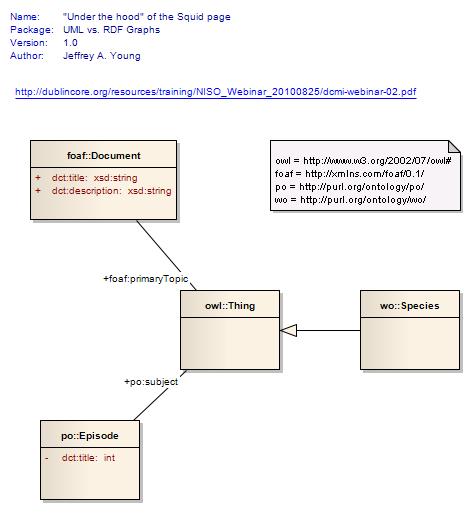- From: Young,Jeff (OR) <jyoung@oclc.org>
- Date: Thu, 23 Sep 2010 13:07:21 -0400
- To: "Thomas Baker" <tbaker@tbaker.de>
- Cc: <public-lld@w3.org>
- Message-ID: <52E301F960B30049ADEFBCCF1CCAEF5909D6C40B@OAEXCH4SERVER.oa.oclc.org>
Tom, In today's teleconference, you mentioned the benefit of being able to visualize the triples and referred to this presentation with RDF graphs as an example: http://dublincore.org/resources/training/NISO_Webinar_20100825/dcmi-webi nar-02.pdf The thing that bothers me about RDF graphs is that they give the impression that the model is completely ad hoc. Using the "Under the hood" slide, I create a UML class diagram variant that I think reveals this example's (implied) model more clearly (see the attached diagram). Another example can be found in my "Bridging OWL and UML" use case: http://www.w3.org/2005/Incubator/lld/wiki/Use_Case_Bridging_OWL_and_UML# Application_of_linked_data_for_the_given_use_case I've started capturing as many OWL ontologies in UML as I can, which makes them very easy to work with. Jeff --- Jeffrey A. Young Software Architect OCLC Research, Mail Code 410 OCLC Online Computer Library Center, Inc. 6565 Kilgour Place Dublin, OH 43017-3395 www.oclc.org <http://www.oclc.org> Voice: 614-764-4342 Voice: 800-848-5878, ext. 4342 Fax: 614-718-7477 Email: jyoung@oclc.org <mailto:jyoung@oclc.org>
Attachments
- image/jpeg attachment: Under_the_hood_of_the_Squid_page.jpg

Received on Thursday, 23 September 2010 17:08:34 UTC